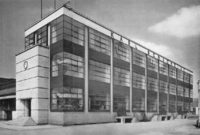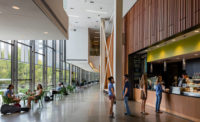From Architectural Record, May 1937
I have been asked by the Architectural Record to write a few words about my new task as professor in the Harvard University Graduate School of Design. I feel rather at a loss to talk much about my academic duties before I have found my bearings in this country and I should like therefore to confine myself only to a few remarks about my general intentions.
I have been in America only once, in 1928. I came here to study the extraordinary building organization, which is at present unsurpassed in the world. It has provided an instrument of such wonderful perfection, that I think any architect would feel inspired and eager to take part in the task of developing the American architecture of the future. I am again deeply impressed by the enormous scale of American architecture.
Whatever the criticisms may be–the ingenuous fearlessness and broad-mindedness of its creators cannot fail to affect everybody. It may seem rather a daring enterprise that I as a European architect venture to add my experiences to the bold planning and amazing technical perfection which you have achieved. I hope my appointment will be a further proof of the American ability to reconcile and amalgamate the most diverse types of people to create a new form of life of typically American stamp.
You may want to hear from me what sort of contribution I wish to make to the development of American architecture, and it may seem rather odd to you that I turn up here to teach Americans what American architecture should be like. I assure you, I feel pretty certain that I shall be a pupil here as well as a teacher, and I am very keen on taking over this double function.
My intention is not to introduce a so to speak cut and dried "Modern Style" from Europe, but rather to introduce a method of approach which allows one to tackle a problem according to its peculiar conditions. I want a young architect to be able to find his way in whatever circumstances; I want him independently to create true, genuine forms out of the technical, economic and social conditions in which he finds himself instead of imposing a learned formula onto surroundings which may call for an entirely different solution.
It is not so much a ready-made dogma that I want to teach, but an attitude towards the problems of our generation which is unbiased, original and elastic. It would be an absolute horror for me if my appointment would result in the multiplication of a fixed idea of "Gropius architecture." What I do want is to make young people realize how inexhaustible the means of creation are if they make use of the innumerable modern products of our age, and to encourage these young people in finding their own solutions.
I have sometimes felt a certain disappointment at being asked only for the facts and tricks in my work when my interest was in handing on my basic experiences and underlying methods. In learning the facts and tricks, some can obtain sure results in a comparatively short time, of course; but these results are superficial and unsatisfactory because they still leave the student helpless if he is faced with a new and unexpected situation. If he has not been trained to get an insight into organic development no skillful addition of modern motives, however elaborate, will enable him to do creative work.
My ideas have often been interpreted as the peak of rationalization and mechanization. This gives quite a wrong picture of my endeavors. I have always emphasized that the other aspect, the satisfaction of the human soul, is just as important as the material, and that the intellectual achievement of a new spatial vision means more than structural economy and functional perfection.
The slogan "fitness for purpose equals beauty" is only half true. When do we call a human face beautiful? Every face is fit for purpose in its parts, but only perfect proportions and colors in a well-balanced harmony deserve that title of honor: beautiful. Just the same is true in architecture. Only perfect harmony in its technical functions as well as in its proportions can result in beauty. That makes our task so manifold and complex.
More than ever before is it in the hands of us architects to help our contemporaries to lead a natural and sensible life instead of paying a heavy tribute to the false gods of make-believe. We can respond to this demand only if we are not afraid to approach our work from the broadest possible angle. Good architecture should be a projection of life itself and that implies an intimate knowledge of biological, social, technical and artistic problems.
But then–even that is not enough. To make a unity out of all these different branches of human activity, a strong character is required and that is where the means of education partly come to an end. Still, it should be our highest aim to produce this type of men who are able to visualize an entity rather than let themselves get absorbed too early into the narrow channels of specialization. Our century has produced the expert type in millions, let us make way now for the men of vision.






